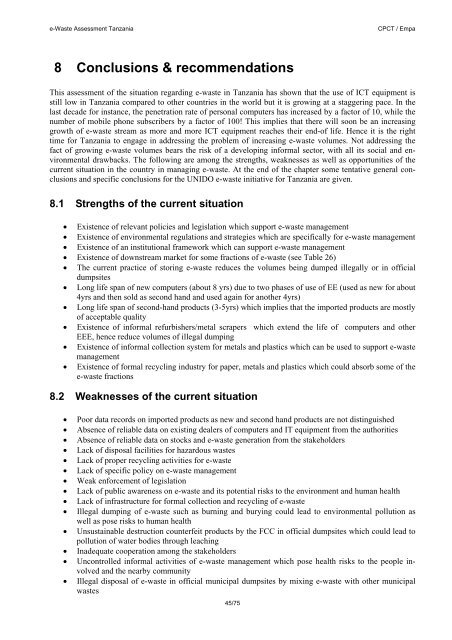e-Waste Assessment Tanzania - e-Waste. This guide
e-Waste Assessment Tanzania - e-Waste. This guide
e-Waste Assessment Tanzania - e-Waste. This guide
- No tags were found...
You also want an ePaper? Increase the reach of your titles
YUMPU automatically turns print PDFs into web optimized ePapers that Google loves.
e-<strong>Waste</strong> <strong>Assessment</strong> <strong>Tanzania</strong>CPCT / Empa8 Conclusions & recommendations<strong>This</strong> assessment of the situation regarding e-waste in <strong>Tanzania</strong> has shown that the use of ICT equipment isstill low in <strong>Tanzania</strong> compared to other countries in the world but it is growing at a staggering pace. In thelast decade for instance, the penetration rate of personal computers has increased by a factor of 10, while thenumber of mobile phone subscribers by a factor of 100! <strong>This</strong> implies that there will soon be an increasinggrowth of e-waste stream as more and more ICT equipment reaches their end-of life. Hence it is the righttime for <strong>Tanzania</strong> to engage in addressing the problem of increasing e-waste volumes. Not addressing thefact of growing e-waste volumes bears the risk of a developing informal sector, with all its social and environmentaldrawbacks. The following are among the strengths, weaknesses as well as opportunities of thecurrent situation in the country in managing e-waste. At the end of the chapter some tentative general conclusionsand specific conclusions for the UNIDO e-waste initiative for <strong>Tanzania</strong> are given.8.1 Strengths of the current situation Existence of relevant policies and legislation which support e-waste management Existence of environmental regulations and strategies which are specifically for e-waste management Existence of an institutional framework which can support e-waste management Existence of downstream market for some fractions of e-waste (see Table 26) The current practice of storing e-waste reduces the volumes being dumped illegally or in officialdumpsites Long life span of new computers (about 8 yrs) due to two phases of use of EE (used as new for about4yrs and then sold as second hand and used again for another 4yrs) Long life span of second-hand products (3-5yrs) which implies that the imported products are mostlyof acceptable quality Existence of informal refurbishers/metal scrapers which extend the life of computers and otherEEE, hence reduce volumes of illegal dumping Existence of informal collection system for metals and plastics which can be used to support e-wastemanagement Existence of formal recycling industry for paper, metals and plastics which could absorb some of thee-waste fractions8.2 Weaknesses of the current situationPoor data records on imported products as new and second hand products are not distinguishedAbsence of reliable data on existing dealers of computers and IT equipment from the authoritiesAbsence of reliable data on stocks and e-waste generation from the stakeholdersLack of disposal facilities for hazardous wastesLack of proper recycling activities for e-wasteLack of specific policy on e-waste managementWeak enforcement of legislationLack of public awareness on e-waste and its potential risks to the environment and human healthLack of infrastructure for formal collection and recycling of e-wasteIllegal dumping of e-waste such as burning and burying could lead to environmental pollution aswell as pose risks to human healthUnsustainable destruction counterfeit products by the FCC in official dumpsites which could lead topollution of water bodies through leachingInadequate cooperation among the stakeholdersUncontrolled informal activities of e-waste management which pose health risks to the people involvedand the nearby communityIllegal disposal of e-waste in official municipal dumpsites by mixing e-waste with other municipalwastes45/75
















